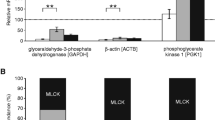Abstract
As there is increasing evidence that Rho–Rho kinase (ROCK) pathway plays an important role in the proliferation and contraction in many tissues, we investigated the contractile role of a ROCK inhibitor, fasudil, and the distribution of RhoA, RhoB, RhoC, ROCK1, and ROCK2 in the rat prostate. Twelve-week-old Sprague-Dawley rat prostate was used in this study. Rat prostatic contractile responses induced by carbachol and norepinephrine were investigated in organ bath studies without or with 10−7, 10−6, and 10−5 M of a non-selective ROCK inhibitor, fasudil. Immunoblot analysis and immunohistochemical staining were performed to investigate the participation levels of RhoA, RhoB, RhoC, ROCK1, and ROCK2. The E max values induced by carbachol and norepinephrine were similar in the rat prostate. Fasudil significantly inhibited carbachol- or norepinephrine-induced prostatic contractions in a dose-dependent manner. Fasudil 10−5 M reduced the initial prostatic contraction (without fasudil) to 56.7 ± 5.9% for carbachol and to 45.7 ± 12.3% for norepinephrine. Amounts of RhoA, RhoB, RhoC, ROCK1, and ROCK2 were detected by immunoblot analysis in the prostate. Immunohistochemical study revealed that RhoA, RhoB, RhoC, ROCK1, and ROCK2 were all positive in the prostatic smooth muscle, while there were some differences of distributions of Immunoreactivities between these enzymes in the prostatic glandula. Our data indicated that rat prostate contains RhoA, RhoB, RhoC, ROCK1, and ROCK2, which play an important role in the autonomic nerve-mediated contractile responses in the prostate.




Similar content being viewed by others
References
Riento K, Ridley AJ (2003) Rocks: multifunctional kinases in cell behaviour. Nat Rev Mol Cell Biol 4:446–456
Rikitake Y, Liao JK (2005) Rho GTPases, statin, and nitric oxide. Circ Res 97:1232–1235
Schwartz M (2004) Rho signalling at a glance. J Cell Sci 117:5457–5458
Liao JK, Seto M, Noma K (2007) Rho kinase (ROCK) inhibitors. J Cardiovasc Pharmacol 50:17–24
Wheeler AP, Ridley AJ (2004) Why three proteins? RhoA, RhoB, RhoC, and cell motility. Exp Cell Res 301:43–49
Christ GJ, Andersson KE (2007) Rho-kinase and effects of Rho-kinase inhibition on the lower urinary tract. Neurourol Urodyn 26(6 Suppl):948–954
Rees RW, Foxwell NA, Ralph DJ, Kell PD, Moncada S, Cellek S (2003) Y-27632, a Rho-kinase inhibitor, inhibits proliferation and adrenergic contraction of prostatic smooth muscle cells. J Urol 170:2517–2522
Takahashi R, Nishimura J, Seki N, Yunoki T, Tomoda T, Kanaide H, Naito S (2007) RhoA/Rho kinase-mediated Ca2+ sensitization in the contraction of human prostate. Neurourol Urodyn 26:547–551
Saito M, Kinoshita Y, Satoh I, Shinbori C, Suzuki H, Yamada M, Satoh K (2007) Ability of cyclohexenonic long-chain fatty alcohol to reverse diabetes-induced cystopathy in the rat. Eur Urol 51:479–488
Saito M, Okada S, Kazuyama E, Satoh I, Kinoshita Y, Watanabe T, Satoh K (2008) Pharmacological properties, functional alterations and gene expression of muscarinic receptors in young and old type 2 Goto-Kakizaki diabetic rat bladders. J Urol 180:2701–2705
Masago T, Watanabe T, Saito M, Kinoshita Y, Sato K, Miyagawa I (2009) Effect of the rho-kinase inhibitor hydroxyfasudil on bladder overactivity: an experimental rat model. Int J Urol 16:842–847
Ohmasa F, Saito M, Tsounapi P, Dimitriadis F, Inoue S, Shomori K, Shimizu S, Kinoshita Y, Satoh K (2011) Edaravone ameliorates diabetes-induced dysfunction of NO-induced relaxation in corpus cavernosum smooth muscle in the rat. J Sex Med (in press)
Erschbamer MK, Hofstetter CP, Olson L (2005) RhoA, RhoB, RhoC, Rac1, Cdc42, and Tc10 mRNA levels in spinal cord, sensory ganglia, and corticospinal tract neurons and long-lasting specific changes following spinal cord injury. J Comp Neurol 484:224–233
Rattan S, Phillips BR, Maxwell PJ 4th (2010) RhoA/Rho-kinase: pathophysiologic and therapeutic implications in gastrointestinal smooth muscle tone and relaxation. Gastroenterology 138:13–18
Author information
Authors and Affiliations
Corresponding author
Rights and permissions
About this article
Cite this article
Saito, M., Ohmasa, F., Shomori, K. et al. Rhos and Rho kinases in the rat prostate: their possible functional roles and distributions. Mol Cell Biochem 358, 207–213 (2011). https://doi.org/10.1007/s11010-011-0936-9
Received:
Accepted:
Published:
Issue Date:
DOI: https://doi.org/10.1007/s11010-011-0936-9




